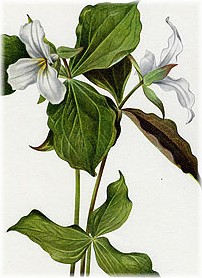Transient Trilliums
By Audrey Stallsmith

He said, “There is not time enough.
All my days are hurry, hurry things.
The press of work keeps me from being free.
The trilliums are blooming on the bank above the creek,
But I have not the time to go and see.
Marie Stallsmith—“Trilliums”
My late aunt wrote the above stanza about the ephemeral flowers that bloom for a few days every spring, and vanish almost as quickly as they appeared. They have been considered sacred plants by some, perhaps because their many threes—three leaves, three sepals, three petals—can be associated with the Trinity. The name trillium is, in fact, derived from the Latin for trio.
But the prohibition against picking them can be a legal one as well, since they are a protected wildflower in many states. From all accounts, they wither quickly after being cut anyhow, so please enjoy them in situ (at their original site).
Native Americans induced birth with trillium root, which explains the nicknames birthroot and bethroot. “Wake robin” derives from the fact that the flowers are supposed to return with the robins. But, in these parts, the impatient birds actually arrive first! Trilliums have also been known as Indian shamrock, ground lily, and whippoorwill flower.
The type most common here, Trillium grandiflorum, can carpet damp woodlands in white. I yearn over photos of the gorgeous—but rare--double form of this flower, Trillium grandiflorum flore pleno. But, as it can be very expensive, I have thus far sternly resisted temptation!
Also attractive, though somewhat malodorous is the red-flowered Trillium erectum. The stink, only noticeable on close inspection, has been compared to wet dog or rotting meat---and attracts the carrion flies which pollinate the plant. Its less-than-flattering nickname, “stinking Benjamin” is supposed to be a corruption of “stinking benzoin.”
Other trilliums include nivale (dwarf or snow trillium), undulatum (painted trillium), sessile (toadshade), luteum (yellow trillium), stramineum (twisted trillium), and vaseyi (sweet trillium). Although most aren’t revered for their fragrance, luteum is said to have a lemony scent and vaseyi a faint rose perfume.
Native Americans boiled trillium leaves in lard to treat ulcers and tumors, and simmered the roots in milk to treat diarrhea. They also applied the grated root as a poultice and drank an infusion of that root to relieve cramps and promote menstruation.
But the plant is still loved most for its unusual blooms. And we would do well to take the time from our busy lives to appreciate them—and our other blessings—while we can. Because as my aunt, confined to a wheel chair near the end of her life, completed her poem:
As for myself, I would not mind the work,
For all my days are empty boring things.
I would so love to help with the gardening.
Chained forever to this chair, to never more be free,
Though trilliums are blooming in drifts along the swamp,
I cannot go and see.
Note: Trillium grandiflorum image is from North American Wildflowers by Mary Vaux Walcott.








